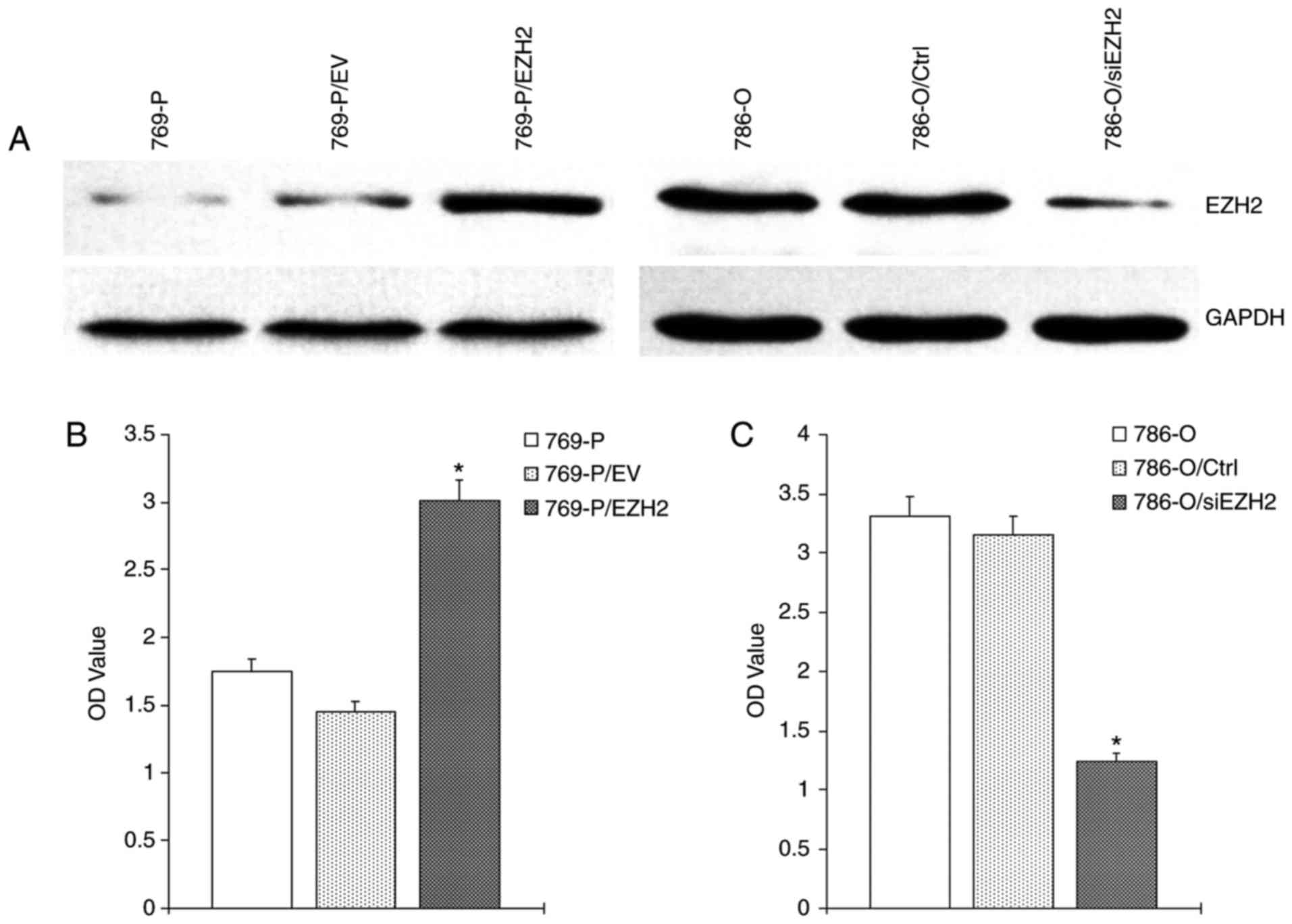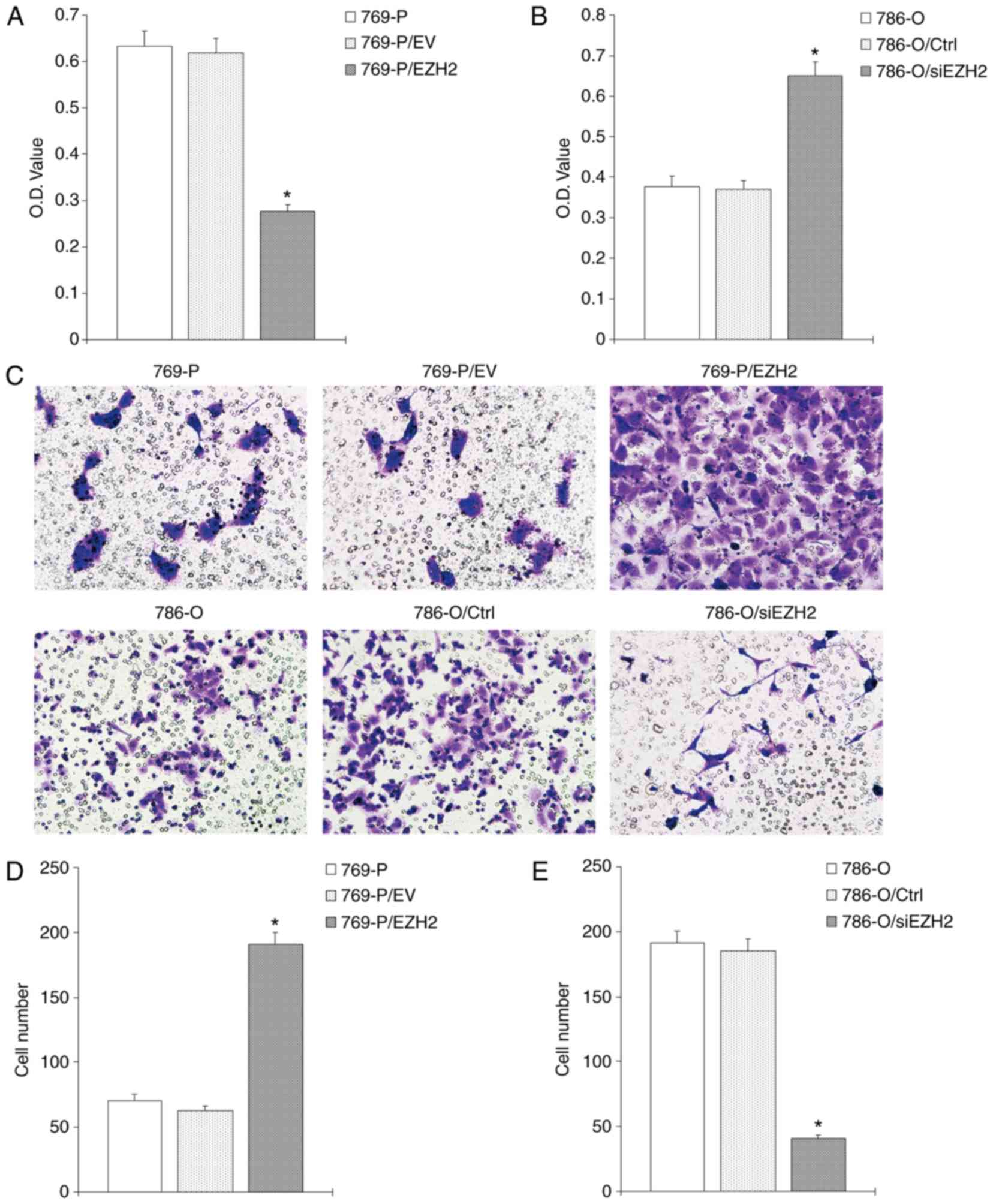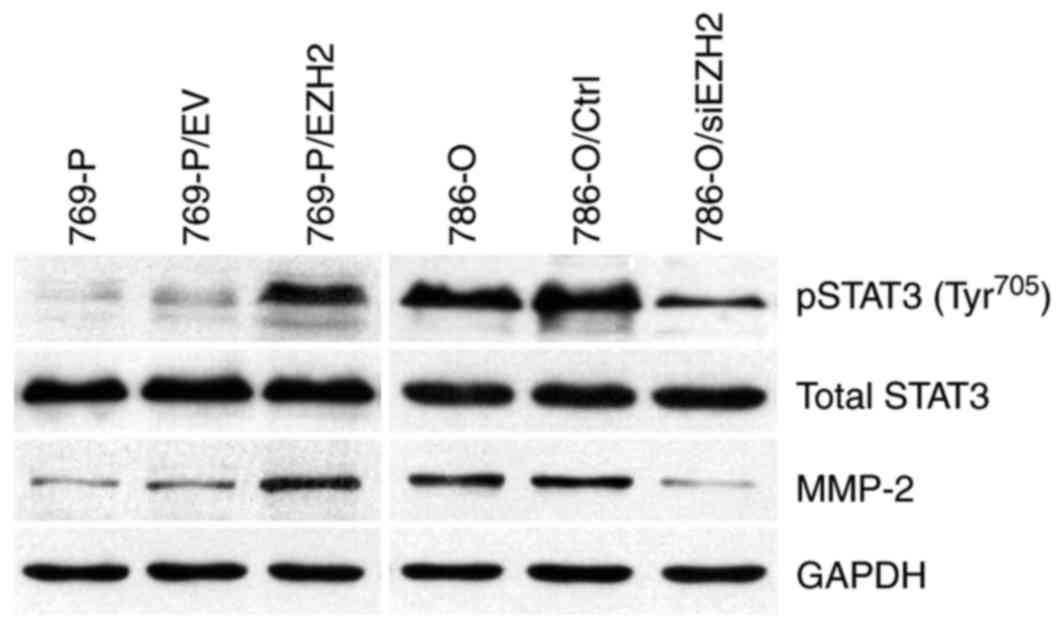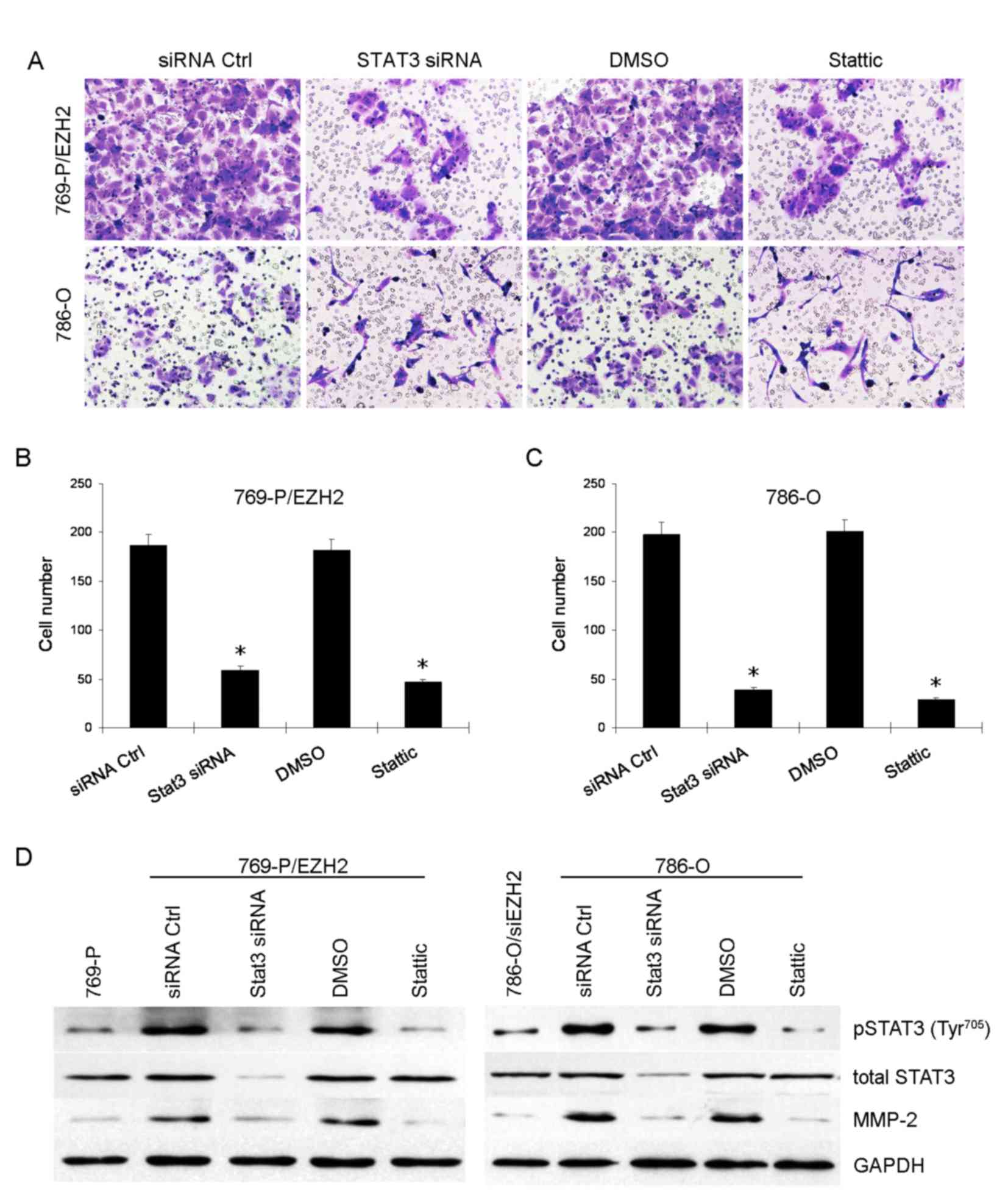EZH2 enhances the invasive capability of renal cell carcinoma cells via activation of STAT3
- Authors:
- Published online on: December 27, 2017 https://doi.org/10.3892/mmr.2017.8363
- Pages: 3621-3626
-
Copyright: © Zhang et al. This is an open access article distributed under the terms of Creative Commons Attribution License.
Abstract
Introduction
Renal cell carcinoma (RCC), which accounts for 85% of malignant kidney neoplasms and ~2% of all human malignancies, is the 8th most common cancer in the USA (1). For patients with localized RCC, radical or partial nephrectomy is the optimal primary treatment (2). However, RCC tends to recur in 20–40% of patients following surgery, depending on the clinical stage and grade of the tumor (3). A total of ~30% of patients with RCC develop metastatic disease, most frequently in the lungs, bones and brain (4). Metastatic RCC is uniquely resistant to chemotherapy and radiotherapy and has a poor prognosis (5,6). For this reason, the identification of novel therapeutic targets and the development of novel strategies for RCC treatment are urgently required.
The enhancer of zeste 2 polycomb repressive complex 2 subunit (EZH2) gene encodes a polycomb group (PcG) protein, which acts as a histone methyltransferase and is able to directly control DNA methylation (7,8). Increasing amounts of evidence indicate that EZH2 promotes development and metastasis in several tumors (9–11). Previous studies have demonstrated that EZH2 may be a valuable prognostic factor in RCC (12,13); however, its potential role and possible mechanism remain uncertain.
In a previous study, it was demonstrated that EZH2 is overexpressed in RCC and that inhibition of EZH2 resulted in apoptosis in RCC cells (14). In the present study the overexpression of EZH2 was demonstrated to increase the proliferation and invasive potential of RCC cells. Mechanically, EZH2 increases STAT3 phosphorylation and upregulates the expression of 72 kDa type IV collagenase (MMP-2). EZH2 may be an attractive target for the management of metastatic RCC.
Materials and methods
Cell culture and reagents
Human RCC cell lines 786-O and 769-P were purchased from the China Center of Type Culture Collection (Wuhan, China) and maintained in RPMI-1640 medium (Gibco; Thermo Fisher Scientific, Inc., Waltham, MA, USA) supplemented with 10% (v/v) fetal bovine serum (FBS; Hangzhou Sijiqing Biological Engineering Materials Co., Ltd., Hangzhou, China) at 37°C with 5% CO2 in a humidified incubator. Rabbit anti-human STAT3, phosphorylated STAT3 (Tyr705) and MMP-2 antibodies were purchased from Cell Signaling Technology, Inc., (Danvers, MA, USA). For inactivating STAT3, cells were treated with 20 µmol/l Stattic (Merck KGaA, Darmstadt, Germany) for 1 h at 37°C.
Establishment of stable EZH2-overexpression transfectants and transient small interfering (si)RNA transfection
EZH2-overexpressing vector and siRNA targeting EZH2 and STAT3 were designed and synthesized by Invitrogen (Thermo Fisher Scientific, Inc.). The following siRNA sequences were used: siRNA EZH2 5′-AAGACTCTGAATGCAGTTGCT-3′; siRNA STAT3 5′-GAAGCAGCAGAUGGAGCTT-3′. Transfection using Lipofectamine® 2000 reagent (Thermo Fisher Scientific, Inc.) was performed according to the manufacturer's protocol. When the cells reached a confluence of 70%, the cells were transfected with EZH2-overexpression plasmid (14 µg in 250 µl RPMI-1640 medium without serum), siRNA targeting EZH3 or STAT3 (20 pmol in 50 µl RPMI-1640 medium without serum), empty vector or control siRNA, respectively. Following 4 h, the plasmid DNA/siRNA lipid complex was replaced with normal medium. Stable EZH2-overexpression cell clones 769-P/EZH2 were selected in complete growth medium containing 3.0 µg/ml blasticidin (Invitrogen; Thermo Fisher Scientific, Inc.). Resistant clones were further verified by western blot analysis, as described below. The studies described here were performed using representative cell clones; similar results were observed with other randomly picked clones.
Bromodeoxyuridine (BrdU) incorporation assay
Tumor cells were seeded at 2×104 cells/well in 96-well plates. The cell growth rate was slowed down by overnight incubation at 37°C (24 h) in serum free medium. A total of 10 mM BrdU was added for 8 h and then the medium was changed for the remainder of the 24 h incubation at 37°C. The cells were subsequently washed with PBS and fixed in 70% ethanol for 25 min at 4°C. The amount of incorporated BrdU was determined using a monoclonal antibody directed against BrdU (Zymed; Thermo Fisher Scientific, Inc.), according to the manufacturer's protocol. The cells were stained with tetramethylbenzidine at 37°C (30 min) for color development. The absorbance [optical density (OD)] was measured at a wavelength of 450 nm using a Microplate Autoreader (Bio-Tek Instruments, Inc., Winooski, VT, USA). Each independent experiment was performed in triplicate.
Cell adhesion assay
Matrigel (BD Biosciences, Franklin Lakes, NJ, USA) was diluted with serum-free RPMI 1640 medium at 1:20 and the bottom of 96-well plate was coated. A total of 5×103 cells were harvested and seeded in a 96-well plate with serum-free medium and allowed to attach to the Matrigel. Following 6 h, medium with unattached cells was removed and MTT was added. Following 4 h of incubation, dimethyl sulfoxide was added to solubilize the formazan crystals and the absorbance (OD) was measured at 590 nm.
Cell invasion assay
The effect of altered EZH2 expression on RCC cells was determined using a Transwell assay. A total of 50 µl Matrigel (BD Biosciences) diluted with serum-free RPMI 1640 medium (1:5) was applied to 8-µm-pore-size polycarbonate membrane filters and the bottom chamber of the apparatus, containing RMPI 1640 medium with 20% FBS. Cells were harvested and resuspended in serum-free RPMI 1640 medium. A total of 5×103 cells were seeded in a Boyden chamber (Corning Incorporated, Corning, NY, USA) and incubated for 24 h. Following incubation, cells on the upper surface were removed and the invading cells attached to the lower surface of the membrane were fixed with 4% paraformaldehyde for 5 min at room temperature and stained with Giemsa for 8 min at room temperature. Cell numbers were counted in three randomly light microscopic fields (magnification, ×20) per membrane. Three independent experiments were repeated.
Western blot analysis
The whole cell lysate was obtained using radioimmunoprecipitation assay buffer (Cell Signaling Technology, Inc.) containing proteinase inhibitors. A total of 30 µg protein was separated by 12% SDS-PAGE and transferred to nitrocellulose membranes. The membranes were initially blocked with 5% skim milk in TBS for 1 h at room temperature. For Western blotting, the primary antibodies included: EZH2 (cat. no. 5246), STAT3 (cat. no. 4904), phosphorylated STAT3 (Tyr705; cat. no. 9145), MMP-2 (cat. no. 87809), and GAPDH (cat. no. 5174) all at 1:1,000. Anti-rabbit IgG, horseradish peroxidase (HRP)-conjugated antibody (cat. no. 7074; 1:5,000) was used as the secondary antibody. All antibodies used in the present study were purchased from Cell Signaling Technology, Inc. Incubation with primary antibodies was performed overnight at 4°C. Following washes with TBS with Tween 20, membranes were incubated with the secondary antibody for 1 h at room temperature and detected using an enhanced chemiluminescence detection system (GE Healthcare, Chicago, IL, USA).
Statistical analysis
Values are presented as the mean ± standard deviation of three independent experiments. Analyses were performed using SPSS 17.0 software (IBM Corp., Armonk, NY, USA). Comparisons between two groups were analyzed using Student's t-test (two-tailed). Comparisons among groups were analyzed using one-way analysis of variance followed by the Student-Newman-Keuls post-hoc test. P<0.05 was considered to indicate a statistically significant difference.
Results
Establishment of stable EZH2 overexpression transfectants and downregulation of EZH2 in RCC cells
Stable EZH2-overexpressing 769-P/EZH2 cells and empty vector control 769-P/EV cells were established following blasticidin screening. Western blot analysis demonstrated that 769-P/EZH2 cell clones had elevated expression of EZH2 (Fig. 1A). To knock down EZH2 in 786-O cells, EZH2-specific siRNA was transfected into 786-O cells, and western blotting was performed to assess the expression of EZH2 following transfection. As exhibited in Fig. 1A, 786-O/siEZH2 cells demonstrated decreased expression of EZH2 following transfection.
EZH2 promotes the proliferation capability of RCC cells
In a previous study, the authors demonstrated that downregulation of EZH2 led to apoptosis in RCC cells. In the present study, the effect of EZH2 alteration on proliferation capability in 769-P and 786-O cells was determined. As exhibited in Fig. 1B, following BrdU incorporation, 769-P/EZH2 cells demonstrated a significantly higher absorbance value compared with parental 769-P cells or control 769-P/EV cells, which indicated that EZH2 overexpression was able to accelerate 769-P cell proliferation (P<0.05). By contrast, knockdown of EZH2 significantly repressed the proliferation of 786-O cells (P<0.05; Fig. 1C).
Inhibition of adhesive capability by EZH2 overexpression in RCC cells
To investigate the effect of EZH2 expression on adhesion ability in RCC cells, Petri dishes were coated with Matrigel to mimic the extracellular matrix (ECM). The ability of the cells to adhere to Matrigel was determined. The value of absorbance at 590 nm of 769-P/EZH2 cells significantly decreased by 1.7-fold compared with parental 769-P cells (P<0.05; Fig. 2A). By contrast, following 6 h of attachment, the value of A590 in EZH2-knockdown 786-O/siEZH2 cells significantly increased by 0.7-fold relative to parental 786-O cells (P<0.05; Fig. 2B). These results indicated that EZH2 expression was negatively associated with the ability of RCC cells to adhere.
EZH2 enhances the invasive potential of RCC cells
The effect of EZH2 expression on invasive ability of tumor cells was subsequently investigated. The 769-P/EZH2 cells exhibited significantly enhanced invasive potential compared with parental 769-P cells, whereas 786-O cells with EZH2 knockdown exhibited a significantly decreased invasive ability compared with parental 786-O and 786-O/control cells (P<0.01; Fig. 2C-E).
EZH2 overexpression elevates the phosphorylation of STAT3 and upregulates MMP-2
Previous reports have demonstrated that STAT3 serves an important role in metastatic progression in RCC (15,16). For this reason, STAT3 activity following altered EZH2 expression was investigated. As exhibited in Fig. 3, EZH2 overexpression increased the phosphorylation of STAT3 (Tyr705) in 769-P/EZH2 cells, while 786-O/siEZH2 cells demonstrated reduced phosphorylation compared with the parental 786-O cells in response to EZH2 knockdown (Fig. 3). MMP-2, which associated with the degradation of various components of the ECM, is involved in tumor invasion and metastasis. Therefore, the expression of MMP-2 in cells with altered EZH2 expression was examined. EZH2 upregulated the expression of MMP-2 in 769-P/EZH2 cells, whereas 786-O/siEZH2 cells revealed a reduced MMP-2 level (Fig. 3).
EZH2 enhances metastatic potential via STAT3 activation
It has been reported that STAT3 may elevate a number of downstream targets, including MMP-2, to facilitate metastasis in cancer cells (17). For this reason, the effect of STAT3 on invasive capability in 769-P/EZH2 and 786-O cells was analyzed. Following treatment with siRNA targeting STAT3 or Stattic, an inhibitor of STAT3, 769-P/EZH2 and 786-O cells exhibited a significantly reduced invasive capability compared with the mock-transfected or vehicle control (P<0.05; Fig. 4A-C). Western blot analysis demonstrated reduced expression of MMP-2 in response to knockdown or deactivation of STAT3 in the two cell lines (Fig. 4D). Based on the above, it was hypothesized that EZH2 enhanced the invasive potential of RCC cells via STAT3 phosphorylation and upregulation of MMP-2.
Discussion
The authors have previously reported that inhibition of EZH2 resulted in cell cycle arrest at the G1/S phase and apoptosis in RCC cells (14). In the present study, the effects of EZH2 on the proliferative ability of RCC cells were further characterized. The results demonstrated that overexpression of EZH2 increased the proliferation of 769-P cells, and decreased viability was observed following EZH2 knockdown in 786-O cells. These experiments clearly indicated that EZH2 does enhance the proliferative capability of RCC cells. The results of the present study additionally suggest that EZH2 may serve an important role in the different stages of RCC development and provide an advantage with respect to tumor growth.
It has been proposed that tumor progression is comprised of several steps, including decreased adhesion, degradation of the ECM, migration and invasion into surrounding tissue, and survival in distant host tissues or organs (18,19). In the present study, it was demonstrated that EZH2 overexpression decreased the ability of 769-P/EZH2 cells to adhere to Matrigel, whereas inhibition of EZH2 led to increased adhesion of 786-O/siEZH2 cells. Furthermore, the results of the present study demonstrated that 769-P/EZH2 cells with ectopic expression of EZH2 included more invasive cells than parental 769-P cells and control 769-P/EV cells, whereas there were visibly fewer 786-O/siEZH2 cells with reduced EZH2 expression compared with parental 786-O and control 786-O/control cells. Based on these results, the authors hypothesize that EZH2 decreases adhesive ability and enhances invasive capability, which may, in turn, facilitate RCC cell metastasis to adjacent and distant tissues and organs.
Increasing amounts of evidence indicate that STAT3 serves an important role in RCC progression and metastasis (15,16,20). In the present study, it was demonstrated that EZH2 overexpression increases STAT3 phosphorylation in 769-P cells, whereas knockdown of EZH2 reduces STAT3 activation in 786-O cells. Previous studies focused primarily on the effect of STAT3 on cell growth ability in RCC cells. The present study demonstrated the metastasis-promoting function of STAT3 in response to altered EZH2 expression. When cells were transiently transfected with siRNA targeting STAT3 or treated with Stattic, a specific inhibitor of STAT3, 769-P/EZH2 and 786-O cells demonstrated decreased metastatic capability, despite the high ectopic or endogenous expression of EZH2. These results suggested that STAT3 may mediate the enhancement of metastatic potential following EZH2 overexpression in RCC cells. It has been reported that a number of STAT3 downstream target molecules, including MMP-2, are involved in regulating tumor progression and invasion (21,22). The results of the present study demonstrated that EZH2 overexpression upregulates MMP-2 expression in 769-P cells. However, knockdown of EZH2 led to a decrease in MMP-2 in 786-O cells. For this reason, it was hypothesized in the present study that EZH2 may regulate the activities of MMP-2 in RCC cells. Previous reports indicate that MMP-2 is a downstream target of STAT3 (17,23). In the present study, when cells were treated with siRNA targeting STAT3 or Stattic, the level of MMP-2 expression was downregulated in response to STAT3 inhibition or inactivation. Based on the above, the authors of the present study hypothesized that EZH2 may regulate MMP-2 expression via STAT3 activation.
In conclusion, the present study demonstrated that EZH2 was able to enhance proliferation and invasive potential in RCC cells, via elevation of STAT3 phosphorylation and upregulation of MMP-2 expression. The results of the present study suggested that EZH2 may have an important role in promoting the metastasis of RCC. As a facilitator of invasion, EZH2 makes a promising target for the management of advanced RCC.
Acknowledgements
The present study was supported by the National Natural Science Foundation of China (grant no. 30500502).
References
|
Siegel RL, Miller KD and Jemal A: Cancer Statistics, 2017. CA Cancer J Clin. 67:7–30. 2017. View Article : Google Scholar : PubMed/NCBI | |
|
Heuer R, Gill IS, Guazzoni G, Kirkali Z, Marberger M, Richie JP and de la Rosette JJ: A critical analysis of the actual role of minimally invasive surgery and active surveillance for kidney cancer. Eur Urol. 57:223–232. 2010. View Article : Google Scholar : PubMed/NCBI | |
|
Chin AI, Lam JS, Figlin RA and Belldegrun AS: Surveillance strategies for renal cell carcinoma patients following nephrectomy. Rev Urol. 8:1–7. 2006.PubMed/NCBI | |
|
Ritchie AW and Chisholm GD: The natural history of renal carcinoma. Semin Oncol. 10:390–400. 1983.PubMed/NCBI | |
|
Curti BD: Renal cell carcinoma. JAMA. 292:97–100. 2004. View Article : Google Scholar : PubMed/NCBI | |
|
Hoffman AM and Cairns P: Epigenetics of kidney cancer and bladder cancer. Epigenomics. 3:19–34. 2011. View Article : Google Scholar : PubMed/NCBI | |
|
Czermin B, Melfi R, McCabe D, Seitz V, Imhof A and Pirrotta V: Drosophila enhancer of Zeste/ESC complexes have a histone H3 methyltransferase activity that marks chromosomal Polycomb sites. Cell. 111:185–196. 2002. View Article : Google Scholar : PubMed/NCBI | |
|
Viré E, Brenner C, Deplus R, Blanchon L, Fraga M, Didelot C, Morey L, Van Eynde A, Bernard D, Vanderwinden JM, et al: The Polycomb group protein EZH2 directly controls DNA methylation. Nature. 439:871–874. 2006. View Article : Google Scholar : PubMed/NCBI | |
|
Varambally S, Dhanasekaran SM, Zhou M, Barrette TR, Kumar-Sinha C, Sanda MG, Ghosh D, Pienta KJ, Sewalt RG, Otte AP, et al: The polycomb group protein EZH2 is involved in progression of prostate cancer. Nature. 419:624–629. 2002. View Article : Google Scholar : PubMed/NCBI | |
|
Bachmann IM, Halvorsen OJ, Collett K, Stefansson IM, Straume O, Haukaas SA, Salvesen HB, Otte AP and Akslen LA: EZH2 expression is associated with high proliferation rate and aggressive tumor subgroups in cutaneous melanoma and cancers of the endometrium, prostate, and breast. J Clin Oncol. 24:268–273. 2006. View Article : Google Scholar : PubMed/NCBI | |
|
Rao ZY, Cai MY, Yang GF, He LR, Mai SJ, Hua WF, Liao YJ, Deng HX, Chen YC, Guan XY, et al: EZH2 supports ovarian carcinoma cell invasion and/or metastasis via regulation of TGF-beta1 and is a predictor of outcome in ovarian carcinoma patients. Carcinogenesis. 31:1576–1583. 2010. View Article : Google Scholar : PubMed/NCBI | |
|
Lee HW and Choe M: Expression of EZH2 in renal cell carcinoma as a novel prognostic marker. Pathol Int. 62:735–741. 2012. View Article : Google Scholar : PubMed/NCBI | |
|
Hinz S, Weikert S, Magheli A, Hoffmann M, Engers R, Miller K and Kempkensteffen C: Expression profile of the polycomb group protein enhancer of Zeste homologue 2 and its prognostic relevance in renal cell carcinoma. J Urol. 182:2920–2925. 2009. View Article : Google Scholar : PubMed/NCBI | |
|
Zhang D, Xue Y, Yang X, Gan W, Chong T, Wang Z and He D: 118 EZH2 is overexpressed and contributes to apoptotic-resistance and metastasis in renal cell carcinoma. J Urol. 185 Suppl:e502011. View Article : Google Scholar | |
|
Santoni M, Conti A, Piva F, Massari F, Ciccarese C, Burattini L, Cheng L, Lopez-Beltran A, Scarpelli M, Santini D, et al: Role of STAT3 pathway in genitourinary tumors. Future Sci OA. 1:FSO152015. View Article : Google Scholar : PubMed/NCBI | |
|
Horiguchi A, Oya M, Shimada T, Uchida A, Marumo K and Murai M: Activation of signal transducer and activator of transcription 3 in renal cell carcinoma: A study of incidence and its association with pathological features and clinical outcome. J Urol. 168:762–765. 2002. View Article : Google Scholar : PubMed/NCBI | |
|
Kim DJ, Chan KS, Sano S and Digiovanni J: Signal transducer and activator of transcription 3 (Stat3) in epithelial carcinogenesis. Mol Carcinog. 46:725–731. 2007. View Article : Google Scholar : PubMed/NCBI | |
|
Coghlin C and Murray GI: Current and emerging concepts in tumor metastasis. J Pathol. 222:1–15. 2010. View Article : Google Scholar : PubMed/NCBI | |
|
Ben-Baruch A: Site-specific metastasis formation: Chemokines as regulators of tumor cell adhesion, motility and invasion. Cell Adh Migr. 3:328–333. 2009. View Article : Google Scholar : PubMed/NCBI | |
|
Qin J, Yang B, Xu BQ, Smithc A, Xu L, Yuan JL and Li L: Concurrent CD44s and STAT3 expression in human clear cell renal cellular carcinoma and its impact on survival. Int J Clin Exp Pathol. 7:3235–3244. 2014.PubMed/NCBI | |
|
Zhang F, Wang Z, Fan Y, Xu Q, Ji W, Tian R and Niu R: Elevated STAT3 signaling-mediated upregulation of MMP-2/9 confers enhanced invasion ability in multidrug-resistant breast cancer cells. Int J Mol Sci. 16:24772–24790. 2015. View Article : Google Scholar : PubMed/NCBI | |
|
Xuan X, Li S, Lou X, Zheng X, Li Y, Wang F, Gao Y, Zhang H, He H and Zeng Q: Stat3 promotes invasion of esophageal squamous cell carcinoma through up-regulation of MMP2. Mol Biol Rep. 42:907–915. 2015. View Article : Google Scholar : PubMed/NCBI | |
|
Qiu Z, Huang C, Sun J, Qiu W, Zhang J, Li H, Jiang T, Huang K and Cao J: RNA interference-mediated signal transducers and activators of transcription 3 gene silencing inhibits invasion and metastasis of human pancreatic cancer cells. Cancer Sci. 98:1099–1106. 2007. View Article : Google Scholar : PubMed/NCBI |













